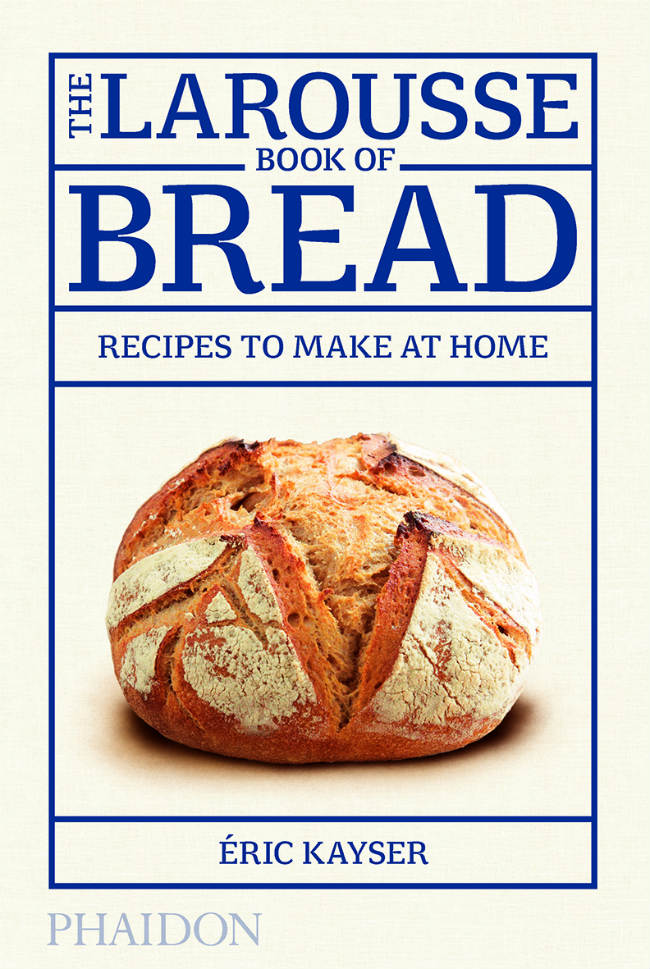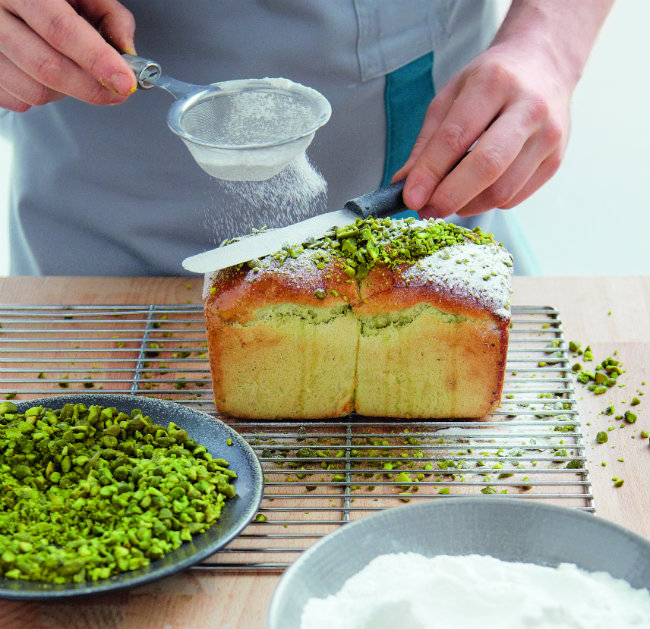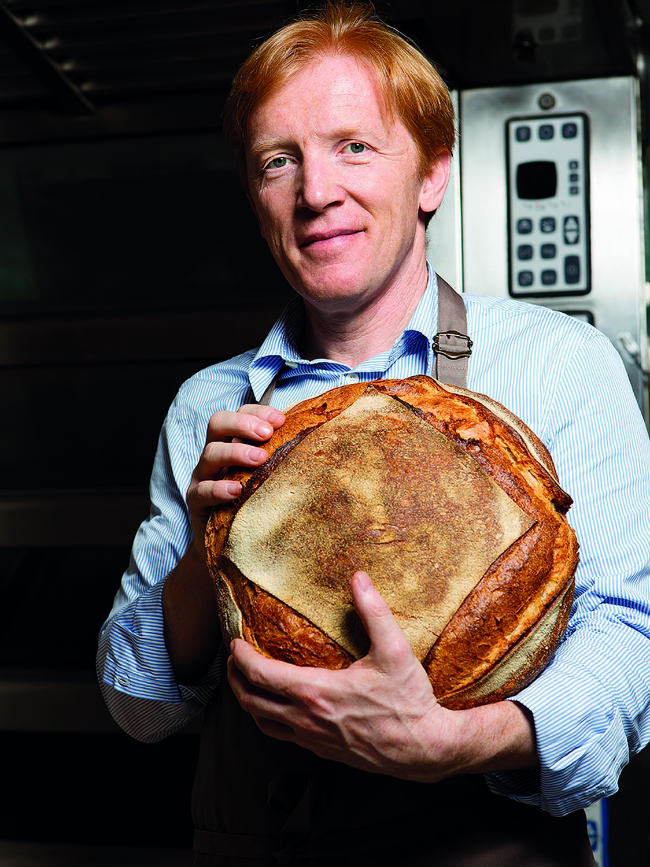Interview with Master Baker Éric Kayser, Plus Recipes from His Book
He may have launched his first boulangerie at 31 but his belated start did not stop Éric Kayser from making his mark in Paris. Two decades on, the boulanger is at the helm of a global brand. Here, the mogul opens the doors of his baking empire.
“Sorry, he keeps running off to the bakery,” reads the apologetic text message from Éric Kayser’s flustered publicist. After an hour spent chasing the elusive boulanger to no avail, it seems he has now truly gone rogue. There is no prying the man from his impeccably laid-out display counter. Not exactly what one would expect from a tycoon with 200 maisons to his name and a phalanx of rank and file quite capable of steering the ship. But the industrious baker was never one to shy away from the nitty-gritty.
“There’s always something more to do,” says a disarmingly upbeat Kayser, freshly marshalled to the phone by his dutiful rep, after yet another impromptu excursion to his very first flagship London bakery – helpfully located on Baker Street. “I’m just a good conductor,” he hastens to add with a chuckle. “Or a pawn, actually,” he reconsiders, without a hint of false modesty. “In a business like ours it’s not the journey of one man, but the journey of a united team. Working in such a tough profession keeps you level-headed. I often say it, and people think I’m just having a moan, but it’s true: you have to be tough and ready to work hard in this job.”
EARLY INITIATION
Raised by a dyed-in-the-wool Alsatian boulanger in a small town of Franche-Comté, Éric learned the value of hard graft from a young age. But his exposure to backbreaking work is as far as his early initiation went. His parents sold up the family boulangerie and packed up for Fréjus in Southern France when he was ten; leaving the bereft little boy with one idée fixe: to one day reclaim his legacy and follow in his father’s footsteps. Of course, many laughed off his grand ambitions to open “many bakeries around the world” (no less) as childish natter.
“Some youngsters dream of being actors, singers. I dreamt of being a baker. I could never picture myself doing anything else,” he says firmly. “Even though I had never really experienced it. All I can remember is baking an apple tart with my father once when I was little. But everything kept bringing me back to this job. People tried to make me change my mind but it was in my blood.”
Undeterred, he ploughed on, biding his time in school before enrolling as an apprentice at the first opportunity. He threw himself into his training “eyes wide open” – and head screwed on. Even so, the industry’s unsociable hours, capped with rather lax labour laws, proved to be a rude awakening.
“There were no restrictions on working hours for minors, and I often started before 1am,” he recalls. “One time, I took a girl out to go dancing and explained that I would disappear by midnight, like Cinderella. When she asked why, I told her that I was a baker… And the spell was broken.”
His apprenticeship barely complete, he was conscripted and posted to a base in Lyon. Craving adventure, and “bored to death”, he begged his superiors to send him away – preferably to the farthest-flung recess possible. He got his wish and within days was shuttled off to war-torn Lebanon with the Blue Berets.
“I had such a hunger to see the world. So I said, ‘I’ll do anything – sniper, tank driver – but please, I need to travel, send me anywhere.’ They were looking for volunteers to go to Lebanon. I said yes. That was the start for me. I was finally going to discover the world. I had quite a tough upbringing but still it was a hard time. We lived together, slept with our rifles. But at 18, I didn’t care. I wanted to live life to the fullest. Nothing could stop me.”
This contretemps would be the first of many to stand in the way of his baking aspirations. Back in France after seven months on the front line, he joined the Compagnons du Devoir. He credits the guild for training him in the finicky art of teaching. Before he quite knew how, he was roped in as a full-time trainer, first with the Compagnons, then at the prestigious Institut National de la Boulangerie Pâtisserie, France’s leading technical college for bakers. All the while he inched further from his childhood dream of heading up his own boulangerie.
“I didn’t really want to but everything seemed to push me towards training. They had taught me so much, I had to give something back. I would travel to Nice for a week, then do some training in Lyon. I spent my life on trains! But in a way it allowed me to do what I do today, training people around the world to run our bakeries.”
Yet he did far more than lounge around in first-class or blindly send new generations of bright-eyed bakers off into a lapsed – and increasingly rudderless – industry; one which had virtually abandoned natural leavens and turned its back on handed-down savoir-faire. In 1994, Kayser embarked on a mission to revive a tradition in its final throes and developed the Fermentolevain, his modern answer to the industry’s identity crisis. The machine was designed to keep liquid leavening agent at just the right temperature, making it easier to work and produce traditional breads with a distinctive nutty flavor and extended shelf-life.
Armed with the award-winning wünder-machine, the baker without a bakery eventually gave himself “a kick up the bum”. After a decade spent circling around his goal, on Friday 13, 1996, he launched Maison Kayser on rue Monge in Paris, a boulangerie bravely peddling old-fashioned breads in a market bent on churning out additive-laden baguettes. Customers lapped up his back-to-basics ethos. The bakery could not peel boules out of the oven fast enough.
“At 31 years old I told myself, ‘Let’s go, what are you waiting for?’” he booms. “It wasn’t easy. It happened too fast and we really weren’t prepared. The production side was fine but the sales side really wasn’t there. It was a learning curve. We had decided to do something completely different, to return to the origins of bread-making, which had nearly vanished in France, and around the world.
“I’m not tooting my own horn,” he adds, ever keen not to come across as boastful, “but lots of young people today tell me that I’ve allowed them to rediscover this traditional way of making bread and to go back to basics. After a year I decided to open a second shop, then a third…”
RESOUNDING SUCCESS
Over the past 20 years he has certainly made up for his belated start. From Mexico to Phnom Penh – the latter a resounding, if unexpected, success, he notes – via New York and, surprisingly, Dakar, his empire is dotted around the globe. With each inauguration, he explains with boyish excitement, he edges closer to ticking off every last destination on his childhood bucket list.
“I always yearned to open bakeries in the world’s capitals and big cities – New York, Singapore, Hong Kong and now London – but also, what was really important for me was to go to developing countries. That’s my greatest pride. We’ve just signed to open in Abidjan and in Nigeria. The work never ends. We’re always opening up somewhere.”
Any mention of cold, hard figures – so many branches simply call for it – are swiftly brushed off with a categorical “I don’t look at the numbers, that doesn’t interest me.” Quickly followed by a pleading “I swear. I just want to discover new places, try new things, create, be on the move, always.”
Abroad – as at home – he is renowned for his inventive recipes, adapted to local taste buds and embracing homegrown ingredients, whether that means sprinkling a pinch of punchy turmeric in good old petits pains or a smattering of earthy matcha in brioche dough.
“The world is my inspiration,” he declares without missing a beat. “My turmeric and nut bread came from my travels in India. There’s the rose-petal bread and one with raspberry seeds,” reels off the bafflingly trim father-of-two, considering his indulgent vocation. (He is a committed runner, it emerges, and has totted up 40-odd marathons around the world so far. That is when he is not strolling along the Seine, or squeezing in a few laps in the pool.)
“Whenever you open a new bakery abroad you’re working with different ingredients. It’s a challenge but it’s also part of the charm of my line of work.”
Some recipes have tickled his customers’ sweet tooth, while others have received a lukewarm reception. No matter, his relentless quest for outlandish flavour combinations and off-beat twists on the plain old fougasse or épi leave him little time to dwell. When his latest seasonal range hits the world’s shelves in a few short weeks, he will already be kneading the next fanciful batch in his mind’s eye.
“I’m extremely lucky, I am really optimistic by nature. I feel down, like everyone else, but only once a year, for about six minutes, and then I’m good to go again,” he says, a deep belly laugh bubbling up. “It’s a difficult job, there’s no doubt about it, but when it’s in your DNA, you don’t have a choice.”

The Larousse Book of Bread – Recipes
to Make at Home by Éric Kayser
These recipe extracts are taken from The Larousse Book of Bread – Recipes to Make at Home by Éric Kayser (Phaidon).
BREAD ROLLS WITH LARDONS AND PECANS
Makes 20 rolls, each about 60g
TIMINGS
Mixing and kneading: 10 minutes
First rising: 1 hour 30 minutes
Resting: 30 minutes
Proofing: 1 hour 30 minutes
Baking: 14 minutes
INGREDIENTS
200g smoked bacon (or lardons) (20% of the dough’s weight)
100g (2⁄3 cup) pecan halves (10% of the dough’s weight)
500g (scant 4 1/4 cups) all-purpose (plain) flour, plus extra for dusting
310g (scant 1 1/4 cups) water at 68 degrees F (20 degrees C)
100g (scant 1/2 cup) liquid sourdough starter (or 25g (3 tablespoons) dry sourdough starter)
5g (1 1/2teaspoons) fresh baker’s yeast
10g (1 3⁄4 teaspoons) salt
METHOD
1 Cut the bacon into matchsticks and brown in a frying pan over medium heat. Then drain in a sieve and mix with the pecans.
KNEADING IN A STAND MIXER
1 Put the flour, water, starter, fresh yeast, and salt in the bowl. Knead with the dough hook for 4 minutes at low speed, then for 6 minutes at high speed. Towards the end of the kneading time add the lardons and pecans and mix in gently.
KNEADING BY HAND
1 Put the flour on a work surface or in a mixing bowl and make a large well in the centre. Pour in half the water, then add the starter, fresh yeast, and salt. Mix well, then add the remaining water and knead until all the flour has been incorporated. Knead the dough until smooth and elastic. Add the lardons and pecans towards the end of the kneading.
2 Shape into a ball and cover with a damp cloth. Leave to rise for 1 hour 30 minutes. It will have increased in volume by the end of the rising time.
3 Divide the dough into 20 equal pieces and shape into balls. Cover with a damp cloth and leave to rest for 30 minutes.
4 Working with one ball of dough at a time, use the palm of your hand to flatten it gently. Fold in a third towards the centre and press with your fingertips. Swivel the dough 180 degrees. Fold in the other edge so that it overlaps in the centre and press again. Then fold one half on top of the other and seal the edges together with the heel of your hand. With lightly floured hands, roll the dough out to form a plump oval. Shape the other rolls the same way. You can also shape the dough into round rolls.
5 Place the rolls on baking sheets lined with parchment (baking) paper, seams underneath. Cover with a damp cloth and leave to proof for 1 hour 30 minutes.
6 Place another baking sheet on the bottom shelf of the oven and preheat to 450 degrees F (230 degrees C). Score the rolls with your favourite design using a bread lame. Just before putting the loaves in the oven, pour 50g (scant 1/4 cup) of water onto the preheated baking sheet. Bake for 14 minutes.
7 Remove from the oven and leave to cool on a wire rack.

Croissants by Éric Kayser
CROISSANTS
Makes 20 croissants, each about 60g
TIMINGS
Mixing and Kneading: 10 minutes
Refrigeration: 4 hours
Proofing: 2-2 1/2 hours
Baking: 15 minutes
INGREDIENTS
500g (4 cups) all-purpose (plain) flour, plus extra for dusting
220g (scant 1 cup) water at 50 degrees F (10 degrees C)
50g (3 1/3 tablespoons) liquid sourdough starter (or 13g (1 1/2 tablespoons) dry sourdough starter)
20g (2 tablespoons) fresh baker’s yeast, crumbled
10g (2 teaspoons) sea salt
70g (1/3 cup) sugar
1 egg (50g), plus 1 lightly beaten egg for glazing
25g (2 tablespoons) softened butter, plus 250g (generous 1 cup) chilled butter
KNEADING IN A STAND MIXER
1 Put the flour, water, starter, fresh yeast, salt, sugar, and 1 egg in the bowl. Knead for 5 minutes at low speed, then for 2 minutes at high speed. Add the softened butter and knead for another 3 minutes.
KNEADING BY HAND
1 Put the flour on a work surface or in a mixing bowl and make a large well in the centre. Add the starter, fresh yeast, salt, sugar, egg, and the softened butter, then pour in half the water. Mix together well, then add the remaining water and blend until all the flour has been incorporated. Knead the dough until it becomes smooth and elastic.
2 Shape the dough into a ball and put it in a bowl. Cover with a damp cloth and refrigerate for 1 hour.
3 Take the chilled butter out of the refrigerator and place it between 2 sheets of parchment (baking) paper. Soften, by lightly running a rolling pin over it, and gradually shape it into a rectangle.
4 Dust the work surface. Use a rolling pin to roll out the chilled dough to a 12×24-inch (30x60cm) rectangle 1⁄8 inch (3mm) thick. From time to time, lift the dough off the work surface to check its size. Roll out the butter to fit one half of the dough rectangle. Lift the butter onto the dough and fold the other half of the dough over it. Turn the dough 90 degrees, so that the opening is to the right.
5 Roll out the dough again to create a 12×36-inch (30x90cm) rectangle. Fold this rectangle into thirds, brushing off any excess flour as you go, if necessary. Wrap the dough in plastic wrap (cling film), and make an indentation with your fingertip in one corner to indicate that you have made one turn. Refrigerate for 1 hour.
6 Dust the work surface and take the dough out of the refrigerator. Repeat the previous step, rolling the dough to a 12×36-inch (30x90cm) rectangle and folding it in thirds. Wrap in plastic wrap and make 2 indentations with your fingertips to indicate a second turn. Refrigerate for 1 hour.
7 Again, roll out the dough again to create a 12×36-inch (30x90cm) rectangle. Fold this rectangle into thirds. Wrap the dough in plastic wrap and make 3 fingertip indentations to indicate a third turn. Refrigerate for 1 hour.
8 Dust the work surface. Unwrap the dough and roll it out neatly to a long 13 1/2 x 22-inch (34x55cm) rectangle, 1/16-1⁄8 inch (2-3mm) thick. Try to make it as straight and even as you can, trimming the edges to neaten, if need be. Fold the dough in half lengthwise, then unfold it and cut it in 2 along the length of the fold.
9 Carefully lift one piece of dough to sit neatly on top of the other. Use a large knife to cut out triangles. Use a 4-inch (10cm) dough cutter as a guide for the length of the triangle bases, with sides 7 inches (18cm) long. Since the dough is in 2 layers, you will get 2 layers of triangles.
10 Roll up the croissants, working from the base to the point. The point should ultimately rest underneath so that it does not unfold during baking. Throughout this process the dough triangles should remain well chilled, otherwise it will be impossible to roll them. If they soften too much, simply return them to the refrigerator.
11 Arrange the croissants on wire racks covered with parchment (baking) paper. Leave to proof for 2-2 1/2 hours. (You could place the racks in a cold oven, which then becomes a proofing chamber. Remember to remove them before preheating the oven.)
12 Place a baking sheet on the bottom shelf of the oven and preheat to 325 degrees F (170 degrees C). Glaze the croissants with lightly beaten egg. Just before putting the croissants in the oven, pour 50g (scant 1/4 cup) of water onto the preheated baking sheet. Bake for 15 minutes. Remove from the oven, transfer the croissants to another wire rack, and leave to cool.

Pistachio loaf by Éric Kayser
PISTACHIO LOAF
Makes about 2 loaves each about 500 g | You will need 2 loaf pans, each about 6 1/2~ 3×3 inches (17×7.5×7.5cm).
INGREDIENTS
500g (4 cups) all-purpose (plain) flour, plus extra for dusting
280g (generous 1 cup) water at 68 degrees F (20 degrees C)
75g (1⁄3 cup) liquid sourdough starter (or 20g (2 1/2 tablespoons) dry sourdough starter)
20g (2 tablespoons) fresh baker’s yeast, crumbled
10g (2 teaspoons) salt
10g (2 tablespoons) milk powder
40g (scant 1/4 cup) sugar
40g (scant 3 tablespoons) softened butter, plus extra for greasing
20g (4 teaspoons) crème fraîche
1 egg, lightly beaten
40g (2 1/2 tablespoons) pistachio paste
KNEADING IN A STAND MIXER
Put the flour, water, starter, fresh yeast, salt, milk powder, and sugar in the bowl. Knead for 5 minutes at low speed, then for 6 minutes at high speed. Add the butter and the crème fraîche and knead for another 4 minutes. Knead well to obtain a smooth dough.
KNEADING BY HAND
1 Put the flour on a work surface or in a mixing bowl and make a large well in the centre. Pour in bowl and make a large well in the centre. Pour in half the water, then add the starter, fresh yeast, salt, milk powder, and sugar. Mix well, then add the rest of the water and blend until all the flour has been incorporated. Add the butter, pistachio paste and the crème fraîche and knead until the dough becomes smooth and elastic.
2 Shape the dough into a ball and cover with a damp cloth. Leave to rise for 1 hour. By the end of the rising time it will have increased in volume.
3 Dust the work surface. Divide the dough into 4 equal pieces and shape them into balls without working the dough too much.
4 Cover with a damp cloth and leave to rest for 15 minutes.
5 Butter the molds. Place 2 pieces of dough in each loaf pan; they should fill them by two-thirds.
6 Brush with the lightly beaten egg. Leave to proof for 1 hour 30 minutes. By the end of the proofing time the dough will have expanded in each pan to form 1 loaf.
7 Place a baking sheet on the bottom shelf of the oven and preheat to 325 degrees F (170 degrees C). Glaze the loaves a second time. Just before putting the loaves in the oven, pour 50g (scant 1/4 cup) of water onto the preheated baking sheet. Bake for 30-40 minutes.
8 Remove the loaves from the oven. Turn them out and leave to cool on a wire rack. Brush them with sugar syrup and sprinkle with finely chopped pistachios. Dust with confectioner’s (icing) sugar, using a spatula angled across the surface of the loaf to achieve a striped pattern.
Purchase the book on Amazon below.
From France Today magazine
Share to: Facebook Twitter LinkedIn Email
Leave a reply
Your email address will not be published. Required fields are marked *





